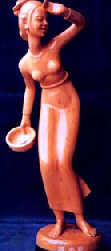 Legend
Legend
 Concerning the origin of boxwood carving, there is a legend, which states the art form was invented by a child cowherd called Ye Chengrong, who was a local of Leqing County inZhejiang Province.
Concerning the origin of boxwood carving, there is a legend, which states the art form was invented by a child cowherd called Ye Chengrong, who was a local of Leqing County inZhejiang Province.
According to the story, one day the boy is playing in atempleat the end of the village, and finds an old man carving a Buddha figure. He is immediately attracted and ties his cow to a tree. Ye finds a piece of sticky mud, and sits in front of the temple to imitate the old man. The old man is a famous local artisan; finding Ye very intelligent and fond of learning, he decides to take the child as his apprentice, and teaches him about the circular carving, clay sculpture, dyeing, gilding (gold plating) and relief.
The old man is a famous local artisan; finding Ye very intelligent and fond of learning, he decides to take the child as his apprentice, and teaches him about the circular carving, clay sculpture, dyeing, gilding (gold plating) and relief.
The boy learns very fast, and a year later masters these skills. One day, while Ye is sculpting some Taoism figures, the Taoist in the temple finds a branch of boxwood and asks him to carve a hairpin. While carving the boxwood, Ye finds the nature of the wood very hard, the grains very exquisite, and the color and luster very outstanding. He deems it a very good raw material to make woodcarving, and conceives boxwood carving, a very rare and precious genre of folk art forms in China.
 Introduction to boxwood
Introduction to boxwood
 As a very precious and rare form of wood, Chinese littleleaf boxwood usually grows in virgin forests, high mountains, or precipices. The plant blossoms in winter, and seeds in spring. A saying goes that "A thousand-year-old boxwood would not be enough to make a pat", which vividly describes its slow growth. Generally speaking, a boxwood plant between the ages of 40 and 50 has a diameter of only 15 centimeters.
As a very precious and rare form of wood, Chinese littleleaf boxwood usually grows in virgin forests, high mountains, or precipices. The plant blossoms in winter, and seeds in spring. A saying goes that "A thousand-year-old boxwood would not be enough to make a pat", which vividly describes its slow growth. Generally speaking, a boxwood plant between the ages of 40 and 50 has a diameter of only 15 centimeters.
Boxwood was used to produce wording boards even before Homer (a classical poet in Greece during theBronzeAge from 2500 to 750BC). Seven boxwood carving masterpieces sculpted between 1736 and 1795 were collected inBeijing's Imperial Palace.
